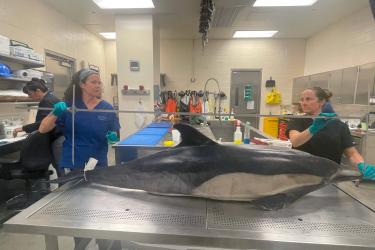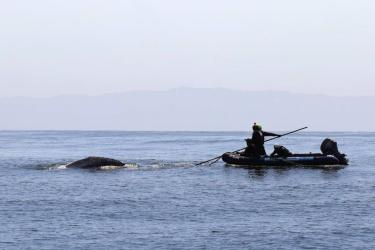We published a final rule today that will require groundfish longline vessels fishing in the exclusive economic zone (3-200 nautical miles offshore) to either use streamer lines (also called tori lines or bait savers) or night set (only deploying hooks between one hour after local sunset and one hour before local sunrise) when fishing north of 36° N. latitude.
This rulemaking is intended to fulfill the terms and conditions of the 2017 U.S. Fish and Wildlife Biological Opinion for seabirds, specifically short-tailed albatross.
The final rule can be found on the Rules and Announcements page.
We published a compliance guide to help you determine what you need to do under this new rule, which is available on our West Coast groundfish fishery page.
The provisions of this rule will be effective on January 10, 2020.
Frequently Asked Questions
Why are we requiring vessels to use streamer lines or nightset?
The action is necessary to fulfill terms and conditions of a 2017 US Fish and Wildlife Service Biological Opinion to minimize take of Endangered Species Act-listed short-tailed albatross (Phoebastria albatrus) in the Pacific Coast groundfish fishery. Streamer lines, also known as tori lines, bird scaring lines, or bait saver lines, have been shown to deter seabirds from the fishing gear groundline for a distance beyond the stern of the vessel sufficient for the groundline to sink to a depth where bait is no longer accessible to diving birds. Due to their nature of hunting primarily during the day, night setting is an effective method to avoid bycatch of short-tailed albatross.
How does this rule change the Seabird Avoidance Program?
Regulations implemented on December 18, 2015, required vessels 55 ft (16.8 m) and longer to use streamer lines. The new regulations, effective on January 10, 2020, extend the streamer line requirements to vessels that are 26 ft (7.9 m) to 55 ft (16.8 m) LOA when using bottom longline gear north of 36° N. latitude. The regulations also add an exemption for all Pacific coast groundfish vessels from the streamer line requirements when night setting and when fishing south of 36° N. latitude and exempt vessels that are 26 ft (7.9 m) to 55 ft (16.8 m) LOA from using streamer lines when a small craft winds advisory is declared by the National Weather Service (NWS).
Who is affected by this final rule?
This final rule applies to any non-tribal groundfish vessel using bottom longline gear at least 26 feet in length or longer fishing for groundfish in federal waters (i.e. three nautical miles from shore and seaward). This includes vessels in the limited entry fixed gear fishery with a longline endorsement (including primary sablefish and sablefish daily trip limit participants), open access fixed gear fishery using bottom longlines, and Shorebased Individual Fishing Quota (IFQ) vessels using bottom longlines (i.e., gear switchers). This rule does not apply for vessels fishing exclusively in state waters (0–3 nautical miles from shore) or for any vessels fishing south of 36° N. latitude (regardless of how far off shore).
What is bottom longline gear?
Bottom longline gear is defined as a stationary, buoyed, and anchored groundline with hooks attached, so as to fish along the seabed. Included in this definition is snap gear (where the hook and gangion are attached to the groundline using a mechanical fastener or snap) and floated mainline gear (where floats and weights are attached to the mainline to reduce isopod predation). Bottom longline gear does not include pelagic hook-and-line, vertical hook-and-line, or troll gear.
What will I need to do under this final rule?
If you are a vessel included in the requirements (see previous question) fishing in an area subject to the requirements (see previous question), you will need to use a streamer line if you are setting your gear during the day (one hour before local sunrise to one hour after local sunset) or you will need to exclusively set your gear at night.
What is a seabird streamer line?
The streamer line is a line that extends from a high point on a vessel (a mast, pole, or rigging) near the stern of the vessel to a drogue (usually a buoy with a weight, such as a section of chain). As the vessel moves forward, the drogue creates tension in the line producing a span of area from the stern where the streamer line is aloft. The aloft section of the streamer line includes streamers made of UV protected, brightly colored tubing spaced every 16.4 feet (5 m). Individual streamers extend to the water to prevent aggressive birds from getting to the groundline and interacting with hooks. Streamer lines have been effective at reducing seabird bycatch in fisheries throughout the world, including Alaskan fisheries that are similar to Pacific Coast groundfish fisheries.
What is the required length and number of streamer lines?
The length of the streamer lines is different depending on whether you use bottom longline gear (including floated mainline gear) or if you use snap gear. The tables on the next two pages explain the length of streamer line you need. Additionally, most boats only need to use one streamer line. The only boats that need to use two streamer lines are those that are over 55 feet that use bottom longline gear (not snap gear).
What if I don’t have a mast, poles, or rigging on my boat?
Vessels without mast, poles, and rigging must deploy at least one buoy bag line. A buoy bag line extends from a high point on the vessel to a drogue. The buoy bag line hangs over the area where baited hooks may be accessible to seabirds, which is generally within 6.5 feet of the sea surface.
What is night setting?
Night setting is deploying gear between one hour after local sunset and one hour before local sunrise. Limiting gear deployment to nighttime is an effective seabird bycatch mitigation measure due to the day-time foraging patterns of short-tailed albatross. If you are using the night setting exemption from streamer lines, gear can only enter the water starting one hour after local sunset and gear deployment must be completed by one hour before local sunrise.
How does this rule affect gear retrieval?
This rule only creates requirements for gear deployment (setting) because this is part of fishing that is most likely to result in injury or death for seabirds. Gear retrieval is not affected by this rule.
What do I do if I accidentally hook a seabird?
You should release live short-tailed albatross that appear to be uninjured on site. You should retain injured, sick, or dead short-tailed albatross and surrender, as soon as possible, as directed by the U.S. Fish and Wildlife Service (U.S. FWS). Report injured, sick, or dead short-tailed albatross to U.S. FWS at (541) 867-4558 x237 or at their general line, (503) 231-6179. See the attached flyer for more information.
How do I get a streamer line?
A limited number of free streamer lines are being made available, please indicate your interest using the available form. Otherwise, streamer lines are available through LFS, Inc., and cost around $130 per line.

